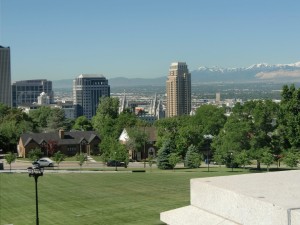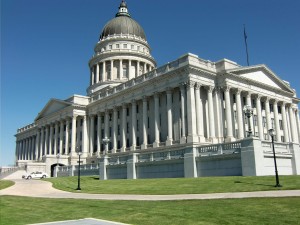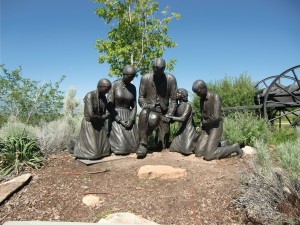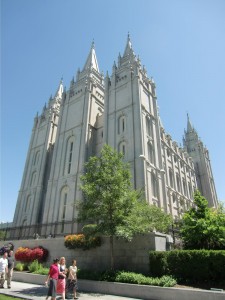THE BEST OF THE WEST – SALT LAKE CITY
THE BEST OF THE WEST
This is the third in a series of articles about traveling the west by bus
SALT LAKE CITY
By Charles N. Stevens
Photos by Dolores Seidman
The day is sparkling clear, perfect for a tour of Salt Lake City. We leave our hotel on a bus, picking up an excellent tour guide, a woman who had worked with the 2002 Winter Olympics. Even though we are at an altitude of 4,300 feet, the snow-capped Wasatch Mountains loom far higher, forming a picturesque backdrop to the city. The first thing we notice as we roll through downtown is that the blocks are unusually long and the streets very wide. The story is that the streets are wide because they needed extra room for the arriving oxen carts to turn around in.
Our guide tells us that all art galleries and museums as well as rides on the trolley within town are all free. She also tells us that horse racing, lotteries and casinos or any form of gambling are not allowed in the state.
We pass the modern architecture of the Salt Palace Convention Center and skirt Temple Square, the center of Mormonism. We can’t help but notice that all women heading for the Temple Square, we assumed as workers, all wore skirts, so different from most cities where pants are the norm. We zip by the Mormon Museum of History and Art and are soon on our way to the State Capitol building high on a hill overlooking the city.
We stroll among the gray polished marble columns and staircases of the capitol, the soft voices of tourist echoing in the vast chambers. I walk out toward the front and stand among the granite columns at a point that provides a panoramic view of Salt Lake City. The tallest building I can see is the headquarters of the Mormon Church. I stood on this very spot at the capitol building sixty-seven years ago in 1944 as a newly minted second lieutenant stationed at the Salt Lake City Fair Grounds, but it was winter then and snow covered the ground and rooftops.
Back inside, the guide tells us that Brigham Young, hearing about the area from Fremont, brought the Mormons west to the Salt Lake Valley in 1847 when it was a vast sloping plain of sage brush and salt grass. I touch the cold polished surface of the Georgia marble columns and look up at the base of the dome where a mural depicts seagulls flying in a pale blue sky. The gulls had arrived on their usual migration, devouring the Mormon crickets that were about to feed on the crops, thereby saving the Mormons from starvation. A giant chandelier hangs from the center of the dome.
Salt Lake City is laid out much as Brigham Young intended it with the temple commanding a central point. He is said to have had 27 wives and 56 children, but polygamy was outlawed in 1890. Today, 40% of Salt Lake City’s population is Mormon, but in Provo it is 80%. Statewide, it is 70%, but in small towns it is closer to 100%.
On the road again, we pass by the impressive campus of the University of Utah. 31,000 students attend the university that is most famous for engineering and mines as well as medicine. The first artificial heart was used here.
We roll by Ft. Douglas, ordered constructed by Lincoln when he feared a possible Mormon uprising, and the site of the Olympic Village, finally arriving at This is the Place Heritage Park. At the mouth of Immigration Canyon, at the point where Brigham Young first gazed out upon Salt Lake and the plains around it, stands a large monument to that event. It is said that, once the wagon train had reached this point, he had uttered, “This is the Place.” Today the canyon and the hills around it are lush and green, the Wasatch Mountains rising majestically behind them. Close by is a Visitors Center, up above it the park containing historical houses that have been moved then restored here.
Back at Temple Square our guide leaves us, turning us over to two Mormon missionary interns who would guide us through the temple complex. One was from Connecticut, the other from Jordan where very few Mormons live. We walk through the immaculate grounds then into a hall with a circular rising ramp leading to a large white statue of Jesus. Here we are told much more about Mormon beliefs. Next we visit the Tabernacle, but have to gaze on its interior through a glass partition. Bluish light surrounds the gold of the organ pipes as an organist plays notes we can barely hear. We end up at the Visitors Center where we see a model of the church and watch a video about the importance of families.
But now it’s time for lunch.

A view over Salt Lake City can be seen from the steps of the Capitol building.

Utah's Capitol Building in Salt Lake City is one of the finest in the United States.

The Mormon Pioneers are remembered at Heritage Park.

The Mormon Temple dominates the skyline of Salt Lake City.
MONTEREY PARK AUTHOR PUBLISHES 3RD BOOK ABOUT HIS EXPERIENCES IN WORLD WAR II- BACK FROM COMBAT
Charles “Norm” Stevens, a 40 year resident of Monterey Park and World War II Veteran has recently published the 3rd in his series about his experiences in WW II, Back from Combat: A WWII Bombardier Faces His Military Future. This book details the time from when he returned from combat in England where he flew 34 missions over Germany and France until the end of the war. Faced with large numbers of returning combat vets, and not knowing how long the war would continue, the military had to plan for their future. His options were whether to return to combat, become an instructor in the U.S., or receive new training that he would use in the Pacific. The book concludes with the end of the war with an Afterward that includes an update on the B-l7’s still flying in the U.S., as well as present day accounts pertaining to the war.
Stevens is the author of two previous books about his experiences:
An Innocent at Polebrook: A Memoir of an 8th Air Force Bombardier (Story of his 34 bombing missions from his base at Polebrook, England over Germany and France)
The Innocent Cadet: Becoming A World War II Bombardier (A prequel to the first, telling of his training in the U.S. before going overseas into combat.)
He is known to the readers of The Citizen’s Voice as the author of Travel Log Articles including “From Paris to Normandy on the Seine”, “Exploring New York” and “In Search of Snow.” He is retired, having taught for 32 years, primarily in the Montebello Unified School District.
Those interested in purchasing an autographed copy of any of his books, may contact the author at 323-721-8230 or Normstevens24@gmail.com.



